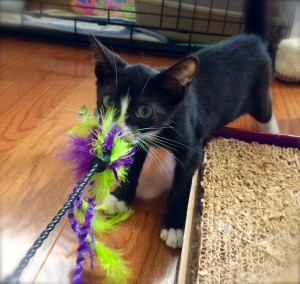By Tooth and Nail: Avoiding Feline Household Destruction
Many people think cats are easy pets to live with, not requiring obedience training like dogs. While they may not need to learn to come when called or heel at your side, untrained cats can cause tremendous household destruction. Destruction by tooth includes noshing on plants, and “Pica,” which means eating inappropriate materials like dirt, leather or wool. Destruction by nail means using the furniture as a scratching post and the curtains as a jungle gym.
Feline destruction can be solved several ways: by managing the problem, by distracting the cat from the objects of desire, and/or by retraining. A combination of all three can solve almost any problem.
Plants at Home
Houseplants often fall victim to young cats. For cats that love eating plants, consider turning tabletop plants into hanging plants or putting plants in one room that’s off-limits to felines. You could also swap live plants for plastic and silk ones.
If you move your houseplants to inaccessible areas, consider also growing catnip and wheat grass in easily accessible areas. Praise and reward interest in “appropriate plants.” This should satisfy the cat’s craving for fresh vegetation. If not, then add some string beans or fruit to your cat’s bowl.
Or you can attempt to retrain your cat by spraying plant leaves with an anti-chew agent formulated for plants, and attaching balloons or double-stick tape to planters. Cats avoid sites of loud noised (popping balloons) or surfaces that feel tacky to their touch.
Pica
If your cat is eating odd things like leather, dirt or wool, then have a veterinarian examine him to ensure he isn’t suffering from a physical problem or metabolic imbalance. Managing the problem could mean keeping attractive objects in drawers, closets, and other closed containers. Also, distract your cat from desired objects by providing lots of playthings. Some experts believe chewing inappropriate items is a sign of boredom and isolation. Longer exercise sessions and rotating toys might bring about a welcome change. Introducing a second cat as a playmate may also help the problem, but only consider this if you truly desire a second cat. Adding cats to a household is stressful initially to the existing occupant, and may cause misbehaviors (e.g. fighting or inappropriate litter box habits) or stress-related health disorders (e.g. Feline Lower Urinary Tract Disease).
 Attempt to retrain your cat through diet. Give him cat a premium quality dry food with adequate fiber in it. Feed only that food and no other supplements or treats, and keep the cat away from his former pseudo-food items for at least two weeks. After two weeks, douse the desired object with and anti-chew spray and reintroduce it to your cat.
Attempt to retrain your cat through diet. Give him cat a premium quality dry food with adequate fiber in it. Feed only that food and no other supplements or treats, and keep the cat away from his former pseudo-food items for at least two weeks. After two weeks, douse the desired object with and anti-chew spray and reintroduce it to your cat.
Scratching Furniture
To manage the #1 destruction complaint — scratching the furniture, ensure furniture and drapery materials are tactilely unattractive to cats (Generally most smooth cotton fabrics, like chintz, or silky fabrics, like parachute cloth, don’t interest cats.) They prefer rough, bumpy, textured surfaces like Haitian cloth, Herculon, raw silk, and leather. If the furniture pre-dates your cat, consider using heavy canvas slip-covers or a comforter to protect your furniture. Of course, there are always plastic slipcovers for the truly desperate! Trimming the cat’s nails every two weeks will keep them blunt and minimize the damage done by any errant scratching.
To distract your cat from furniture, provide a scratching post. To remove dead nail sheaths around their claws, and allow new nails to grow out, cats have an inherent need to scratch. A sturdy, wide-based rough textured post that’s at least three feet tall, and covered in sisal, burlap, or a similar rough fabric is best. Since the urge to scratch is strongest upon awakening, keep the post near your cat’s favorite napping place or by a window.
Scratching also marks territory. Cats often mark an item that’s prominent in the territory, like the corner of a sofa or wall, as a visual signpost. Cats also have scent glands in their feet which mark items with their scent. (This is why declawed cats will “scratch” and mark items.) Initially, it’s important to place a scratching post beside (or in front of) items your cat usually scratches, then move it slowly to the place where you’d prefer it to be. Retrain the cat not to scratch furniture by making them undesirable – cover them with double-stick tape, balloons, tin foil, or contact paper (sticky side out)
The sound of human nails run over the scratching post often entices cats to the post. Praise the cat if they scratch when you do. Dragging a ribbon or other interactive toy over or around the post also attracts the cat. If your cat responds positively to catnip, then sprinkle a potent version on the post several times a month to increase its desirability.
By providing for a cat’s physical and mental needs, and keeping its environment stimulating with kitty greens, appropriate scratching posts, and challenging interactive toys, you can avoid much of the destruction caused by tooth and nail.
Adapted from a Jacque Lynn Schultz article, ASPCA, revised 2000, www.aspca.org
